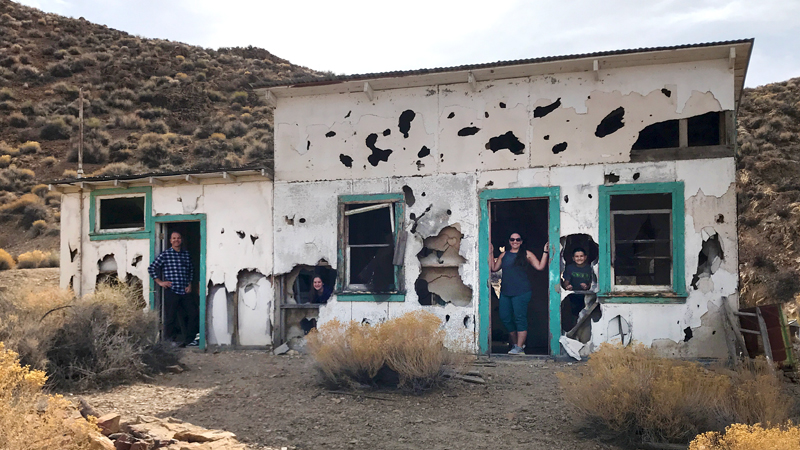
From the steep drive up to the the 360 degree view point, everything about Death Valley’s Aguereberry Point was amazing. But after taking in the view, hiking up the rocks, and walking out to the edge of the point, I was itching to get back down to the remains of Eureka Mine, Cashier Mill, and Aguereberry Camp and do some exploring.
Eureka Mine And Cashier Mill
Our first stop was the parking area at Eureka Mine. To the left, a large wooden structure rose from the mountainside that was so interesting, we decided to check it out before the mine.
The structure is part of the Cashier Mill ruins. Built in 1909, Cashier Mill was powered by gasoline engines. It pulverized the ore then chemical processes using mercury and cyanide extracted the gold. The mill site and surrounding mines were originally part of Shorty Harris’ claim, which he sold to the Cashier Mining Company. Aguereberry later bought the mill site, adding to the seven Death Valley mining claims he already owned.
Up above the mill ruins, were more ruins that begged to be explored, so we hiked up the mountainside to check them out and found more mine shafts, abandoned mining equipment, and a majestic, 360 degree view of the desert landscape. We could even see the ruins of Aguereberry camp.
We then hiked back down the mountain and made our way over to the entrance to Eureka Mine, which still has ore cart tracks running into it. We peeked into the mine and explored some of the mining equipment left to rust before heading to Aguereberry Camp.
Eureka Mine History
In 1905, Pete Aguereberry was headed up to Ballarat with Shorty Harris, and along their journey Pete found a ledge that looked promising, and indeed it contained free gold. Pete filed claims for himself on the north side of the hill while Shorty took claims on the south side.
By August, at least 20 parties were working in the area and samples of the gold were assayed as high as $500 a ton. Three hundred men and women settled into the camp which became known as Harrisburg. It was supposed to be called Harrisberry, but Shorty changed the name when telling the story about it.
By 1907, the Eureka mine was tied up in a litigation battle that ended in 1909 when Aguereberry got control of the claims. He worked at the mine from 1907 until the early 1930s when his health deteriorated. Other than a little help from his nephew, the Eureka mine was built and worked by Aguereberry alone.
Did You Know? Death Valley has more abandoned mines than any other national park. Most mines, including Eureka Mine however, are closed to the public and covered with bat-friendly gates, but you can peek inside.
According to interpretive displays at the mine site, “Gold from the Eureka Mine sustained Pete Aguereberry for 40 years. Historians estimate that Aguereberry extracted about $175,000 worth of gold (then valued at $20 per ounce) from Providence Ridge during his lifetime.”
Aguereberry Camp
Aguereberry Camp, also known as Harrisburg, is a small abandoned mining settlement where Pete Aguereberry lived until his death in 1945.
Only three abandoned structures remain:
- The building on the right is Aguereberry’s original two-room cabin built in 1907.
- The middle cabin was built in 1941 as a guest house — Pete took visitors on tours of his mine and out to what is now Aguereberry Point to see what he called The Great View of Death Valley.
- The cabin on the left was built around 1946, but the reason for the structure is unknown.
I love exploring abandoned buildings of any kind and make Brian stop on all of our road trips when I see them alongside the road, so this was such a cool experience. The textures of the abandoned buildings, the sunlight pouring through the holes, cracks, and openings, the rust, and the erring glimpse into the past are fascinating. Even the kids enjoyed walking through the Death Valley ghost town buildings to see how the miners lived — as long as they avoided the rat poop.
Know Before You Go
- To reach the ruins of Aguereberry Camp (Harrisburg) and remains of Eureka Mine from Furnace Creek, follow CA-190 until you turn left on Emigrant Canyon Road. In about one mile, you’ll see a turn off for Aguereberry Camp. From here you can walk up to Eureka Mine and around the mountainside to the ruins of Cashier Mill, or you can hop back in the car and drive further up the main road to the Eureka Mine parking area.
- If you have time, hike up the mountain above Cashier Mill for an amazing 360 degree view of the valley and an opportunity to spot other mines in the surrounding mountainsides.
- Aguereberry Point, located in the Panamint Mountain Range, is a scenic viewpoint in Death Valley National Park, California 92328, Inyo County.






















